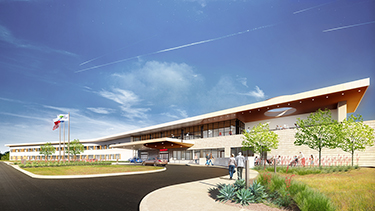|
Subscribe / Renew |
|
|
Contact Us |
|
| ► Subscribe to our Free Weekly Newsletter | |
| home | Welcome, sign in or click here to subscribe. | login |
Construction
| |
 |
July 29, 2021
Micro hospitals offer the right prescription
Perkins & Will

Hinthorne
|

Henson
|
Health care systems are facing continued pressure to control costs, especially coming out of the pandemic, as volumes and associated revenues have not yet caught up to pre-pandemic levels. Providers must deliver a wide range of complex treatments in the most appropriate and cost-effective settings to a diverse and growing population while also focusing on prevention and wellness.
Traditional hospitals remain vitally important, but out of economic necessity they must focus on the highest patients and needs such as complex surgeries, intensive care, trauma centers — any medical needs requiring specialized physicians, nurses, technology and equipment. The familiar large medical centers are typically based in much more urban centers where expenses for real estate, rent, labor and facility management are at a premium.
As an alternative to large medical campuses, and the services that are most appropriately provided in those settings, we are seeing a proliferation of micro and critical access hospitals across the country to improve access, increase efficiency and contain costs. There are many services and procedures that don’t require a visit to the hospital and the relative cost of these facilities is significantly less.
Micro hospitals are increasingly becoming part of the solution as they provide highly efficient care, just-in-time delivery, convenience and importantly, cost savings. We are all getting more comfortable with telehealth services and urgent care centers — both of which meet their needs without setting foot in a major hospital or medical center. And micro hospitals offer more than an emergency room as they have both inpatient and outpatient services.
There will continue to be a real need to build new, modern facilities in areas with growing populations. All providers and systems are wrestling with the challenge of how to deliver health care economically to serve today’s needs. Micro hospitals make access to care much more feasible as patients seeking routine medical services don’t have to travel as far from their homes. And providers can relocate less expensive treatments to a location that can be built and operated at greatly reduced costs while delivering the desired efficiencies and cost effectiveness.
As an example, we are working on a project in the Midwest that is a completely different model. There is such a great need for services in that community that we are expediting the design process with a developer to deliver the building as quickly as possible. A consultant is analyzing the medical needs of the region to maximize the ideal throughput that is informing our design.
We are all working to create an asset for the community. Many include meeting rooms that can be used as gathering spaces, including wellness clinics to bring people together and improve their overall health.
Once you commit to a micro hospital, it must be right — the right services in right amount of space in right place for the right reasons. Projects take a long time to conceive, justify, define, re-justify, build and operate. The building also must be flexible and adaptable over time — flexible to accommodate multiple potential uses in same space, and adaptable to accommodate different uses over time.
From the outset of the design process, we consider the appropriate services in appropriate facilities to optimize the outcomes most cost effectively. The care must be exemplary, meeting the highest of possible expectations as lives depend on it. But the buildings must deliver the best quality at the lowest price. And it’s always important to understand the design of the facility will aid in recruiting and retaining staff and physicians.
There is always a balance:
• Consolidated and dispersed. Trends toward consolidation of highest acuity versus distribution of lowest acuity. In other words, people to the care versus care to the people.
• Expensive and affordable. High acuity services cost more and require larger investments in technology and specialist. Outpatient services can be done in lower cost facilities, requiring less infrastructure, more flexible space, and cross trained staff.
• Performance and prosperity. Preservation of resources, both natural and financial.
• Clinical and comfortable. Creating an environment where everyone feels safe knowing they have everything they need to get outstanding care.
We will absolutely continue to see expansions of inpatient and diagnostic facilities to alleviate the pressures within the complicated health care system. Providers can’t afford not to do it.
Look around our region. Every major institution and system is building new facilities — UW Medicine, Harborview, Swedish, Providence, Kaiser Permanente, Peace Health, Overlake, Evergreen, SCCA and Seattle Children’s. Part of it is driven by growth and an aging population, but part of it is outdated facilities. We have a tangible need for consolidation to handle increasingly complex cases and that will take an organized network of health care facilities that prioritize what can and should be treated and where. In some cases, micro hospitals offer just the right prescription.
Brad Hinthorne works on health care, higher education, mixed-use and multifamily developments. Maria Henson has dedicated her career to health care spaces.
Other Stories:
- Aggregation will drive a new hybrid science space
- Alternative delivery benefits health care in Washington
- Next-gen health care: Building healthier communities, economies
- The shape-shifting needs of the health care industry
- Best practices in health care development and delivery
- How flexible design served OHSU during the pandemic
- The shifting need for design in health care services
- Evidence-based design improves dialysis treatment experience
- Compounding pharmacies provide community resource



